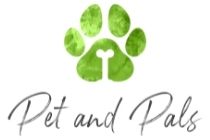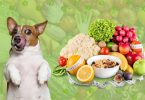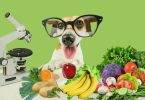Do you love your pet, hate the idea of feeding him processed food and would you like to use natural homemade dog food?
You’re not alone! A lot of people feel the same way. That’s why we’ve put together this guide on how to start feeding your dog natural food. It’s easier than you think, and your pup will love you for it!
We love our dog. After all, dogs are loyal and cute, and above everything else, dogs make us happy. For a while now, raw dog food diets have become increasingly popular since most dog owners do not want to feed dogs processed food. This is because of the increasing cases of dog tumors and other diseases associated with processed dog food.
Dogs are individuals too, and what works for one dog may not work for another dog. Therefore, natural homemade dog food diets are unique for each dog.
Other concerns associated with processed dog food are:
- Dog has food allergies
- Problems gaining or losing weight
- Digestive issues
- Common affliction that may affect dogs
For such concerns, natural homemade dog food might be the silver bullet. Natural dog feed is what dogs were intended to consume, and the dog will get proper nutrients and thus have overall improved health.
What is natural food?
Biologically Appropriate Raw Food (BARF) involves feeding the dog bones and raw food. An Australian veterinarian, Ian Billinghurst, suggested that feeding dogs as nature intended or as evolution intended improves the health and well-being of dogs as opposed to feeding dogs grain-based commercial dog food. He states that most commercial dog food is not digestible.
Feeding your pet with natural homemade dog food has its benefits and risks. The documented benefits of a BARF diet are:
- The dog gets a shinier coat, and the fur is much healthier and smoother
- The dog has healthier skin and, as a consequence, a healthier coat
- The dog has cleaner teeth as grains and fiber tend to stick in between teeth and may make your dog uncomfortable. Additionally, the stuck food fibers may cause dental issues
- The dog has higher energy levels since the natural food is more digestible, and the dog can derive energy and nutrients easily from it
- If the dog had allergies or digestive issues, these are likely to be a problem of the past, and the dog may get improved appetite and better feeding habits
- Since the dog can digest and absorb most of the food, the dog produces smaller stools. The stools are also less stinky and are well formed
On the flip-side the potential risks of a BARF diet are:
- The dog is at a higher risk of illness from bacteria in contaminated raw meat. Dog diseases may also pose a problem to the owner and children. Note that some bacterial infections are transmittable to humans
- Some natural dog feed may precipitate an unbalanced diet, and this may end up damaging the dog’s health in the long term
- There is also a risk of whole bones chocking the dog or causing internal punctures
Creating a raw diet meal for your dog
Dogs, just like humans, derive their energy from protein, carbohydrates, and fat. The three macronutrients provide the calories needed to have the dog strong, happy, and healthy.
Proteins have building blocks called amino acids. Amino acids are the molecules that the dog will utilize to make its tissue, enzymes, and energy. Enzymes are used in various metabolic processes and help speed up digestion, among many other bodily functions.
Fats are a valuable source of energy and can provide double the amount of energy derived from proteins. Whereas fats are essential for cellular function and normal body physiology, feeding dogs too much fat may lead to obesity and heart problems. Fats are used by the dog to make hormones and to absorb fat-soluble vitamins from the diet.
Dogs will die without a proper supply of fats and proteins. Fats and proteins are essential nutrients, whereas carbohydrates are not. Dogs will do just fine with a low supply or even with no carbohydrates.
Balancing the fat
As mentioned earlier, proteins and fats are vital. However, the quantity matters. Feeding dogs proteins and fats is as simple as buying ground meat and putting it in the dog’s bowl. To get the fat right, ensure that approximately 10% to 20% of the dog’s food is fats. This percentage should include any fats like fish oil that the owner may add to the dog’s diet. The remainder of the food should be protein.
Why is there such a strict range for the amount of fat fed to the dog?
Excessive Fats
Fat usually has no vitamins or minerals and is essentially pure energy. The latter presents a challenge because if the dog’s diet is more than 20% fat, the fat eats into the dog’s vitamins and minerals. The diet then becomes nutritionally deficient and may harm the dog, especially for puppies and older dogs.
Deficient Fats
Fat levels in your dog’s diet below 10% will lead to the dog developing itchy, dry skin. Dry skin is the first indicator that the dog is fat deficient.
There are two properties of fat we consider while preparing raw dog food. We look at the degree of fat saturation and whether fats belong to the omega family.
Fats can be saturated, monounsaturated, and polyunsaturated. We encourage mostly saturated and polyunsaturated fats. To keep saturated fats low:
- Get more herbivore meat or mix beef and poultry meat
- Add polyunsaturated oils to low fat meals e.g. fish oils
- Do not use coconut oil in natural do food preparation since it is saturated
Omega fats are classified as either omega-6 or omega-3 fats. We advise that you pick more of omega-3 than omega-6. Omega-6 is pro-inflammatory while omega 3 is anti-inflammatory. To properly balance omega fats
- Remove the skin from poultry
- Avoid feeding pork if the pig was not grass fed
- Try and feed the dog both poultry and ruminants like goats and cows
- Supplement omega-3 fats using sources such as hemp
When deciding on raw homemade dog food, understand that bone is an excellent source of minerals. If it is impossible to incorporate some aspect of bones into the dog’s food, do so. Sources of bone supplements include eggshell powder, seaweed, and coral. However, these three are deficient in magnesium, so the best bone substitute for dogs is bone meal. Replacements are also crucial for small dogs or dogs that are unable to chew through bone.
Getting the minerals and vitamins right
It is prudent for dogs to consume natural foods rich in the appropriate quantities of minerals and vitamins.
Minerals
Minerals and trace elements are essential cofactors that are involved in the metabolic processes of dogs. While proteins make the enzymes, minerals provide the support needed for the enzymes to work. Lack of minerals can lead to dog diseases like joint disease, heart problems, seizures, to mention a few. While this may sound frightening, balancing minerals is easy using bones.
Bone comprises about 65% of minerals such as calcium, magnesium, zinc, and phosphorus. Calcium and phosphorus improve the dog’s muscle coordination. Additionally, calcium and phosphorous are excellent for overall good health and are essential in other processes too.
Meat is rich in phosphorus, and feeding dogs boneless meat means that the dogs will derive calcium from their bones. Bone resorption leads to joint disease and is common in growing dogs like puppies.
Therefore, it is commendable to ensure that 10 to 15 percent of the dog’s diet is bone to support the dog’s musculoskeletal development. The percentile demand is notably higher for growing puppies and old dogs.
It is crucial to ensure that the bone sizes included in raw dog food are appropriate for the dog and that the dog can eat all the bones provided. As a cautionary measure, try and avoid bone sizes that the dog can swallow whole.
Such an approach is vital since whole bones may be difficult to digest or cause intestinal blockage or perforations. Stay away from weight-bearing bones since this can break teeth or get stuck in the intestinal tract. Preferably, feed the dog with bones with a lot of joints or meaty bones with joints.
Bone choices to pick from include:
- Poultry like chicken, duck, or turkey
- Lamb
- Rabbit
- Pork
- Beef
Vitamins
Vitamins are the crucial micronutrients needed by dogs.
Organ Meats
Not all proteins are the same, and some proteins are richer in minerals and vitamins. Organ meats such as heart, liver, kidney, pancreas, lungs, and the rest are natural multivitamins.
However, the largest source of vitamins is the liver. The liver supplies vitamins B and C and minerals like copper and folate. As a result, the liver should comprise about 10% of the total feed but do not limit the feed to the liver only. Add other organs like the heart, kidney, spleen, and pancreas.
Adding vegetation such as fruits and vegetables has been shown to reduce the risk of dog cancers. Therefore, natural food for dogs should have meats and bone and vegetation with antioxidants and short-chain fatty acids.
To cover all bases, we encourage providing micronutrients in raw dog food. Some of the micronutrients are:
Vitamin D
Dogs cannot make vitamin D from sunlight like humans. We also would not want excess vitamin D since it would damage the dog’s kidneys. Therefore, there is a need to balance vitamin D deficiency and vitamin D excess diet. Excellent vitamin D sources are:
- Mushrooms
- Fatty fish
- Egg yolk
Manganese
Manganese is vital for critical metabolic processes. Natural dog feed diets are very likely to be deficient. Manganese deficient dogs are likely to suffer joint problems, which affects their mobility. Manganese is found in spinach, mussels, oysters, and shellfish.
How much raw dog food is appropriate?
The age of the dog determines the quantity of natural dog food given to dogs. Ideally, the feeding requirement for adult dogs is two to three percent of the dog’s weight. A more active dog will require a little bit more and a lazier dog a little bit less. To determine whether the dog is well-fed, try to feel for the dog’s ribs. If the ribs are felt but not seen, then your dog is okay.
As for puppies, we encourage about 5 to 10% of the puppies’ current weight. The increased percentile is due to increased growth demand. We urge that the puppy gets more calcium and less fat than adult dogs.
How to start feeding your pet with natural homemade dog food
When the decision is made to switch to natural dog feed, we encourage weaning the dog off the commercial feed first. Gradually introduce the natural diet. Weaning may involve mixing foods in ratios from 50:50, then 75:25, and finally 100% raw dog food.
We hope that this article serves as a guide on how to start feeding dogs natural food. Natural foods are a healthier alternative for a happy, active dog.







